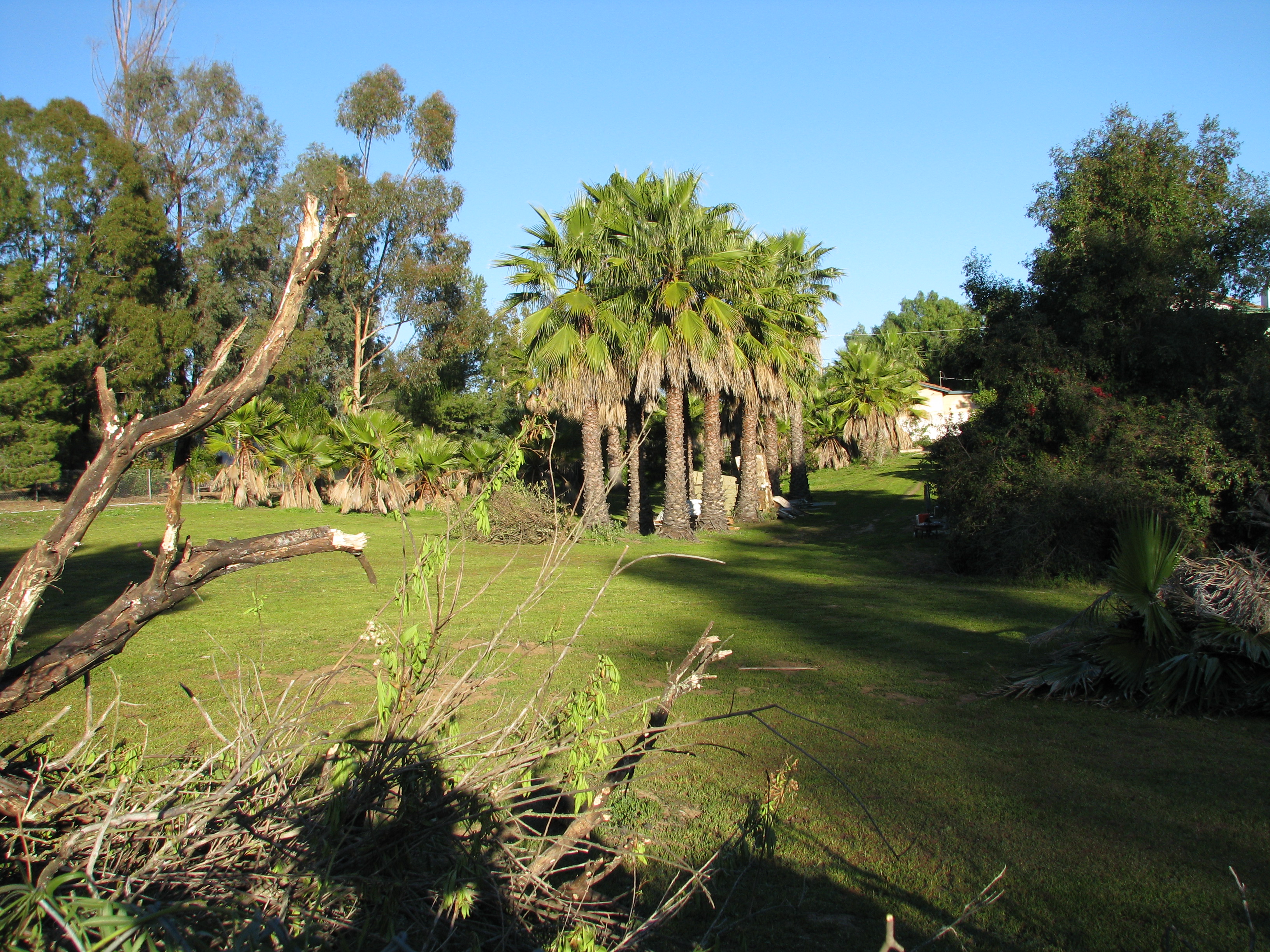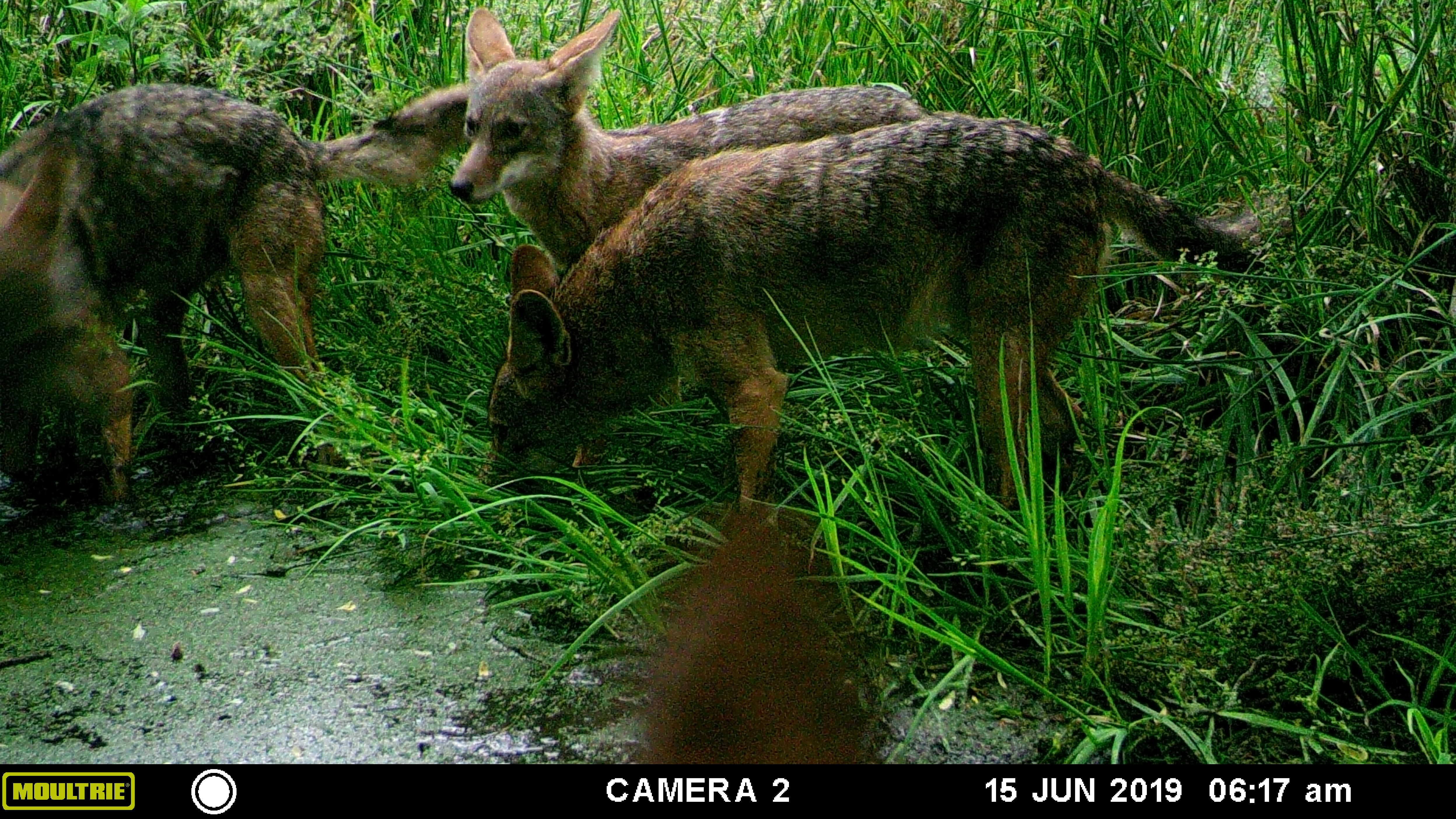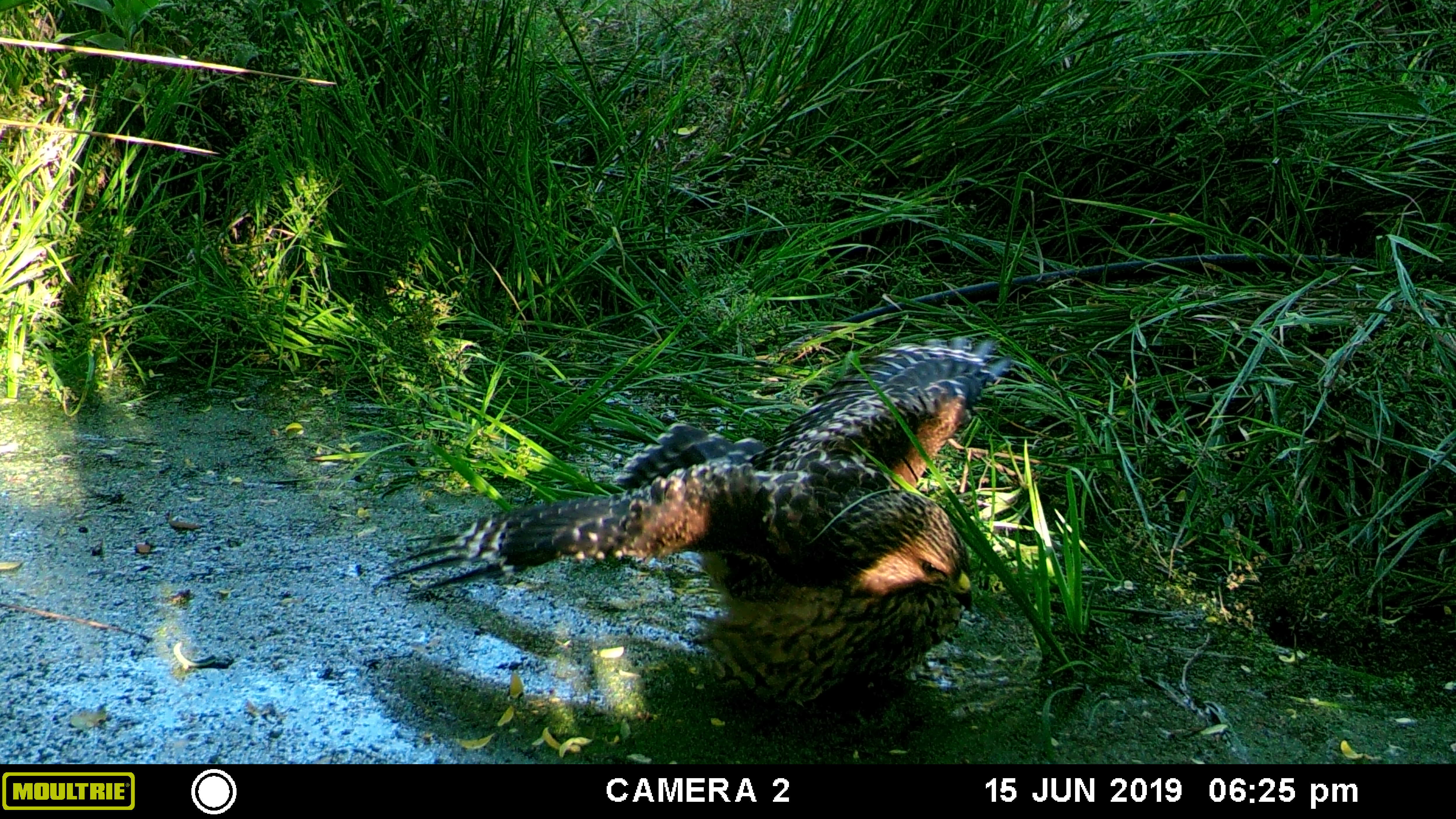- Animals, Bees, Birding, Gardening adventures, Natives, Other Insects, Permaculture and Edible Forest Gardening Adventures, Ponds, Rain Catching, Soil
Summer At Finch Frolic Garden
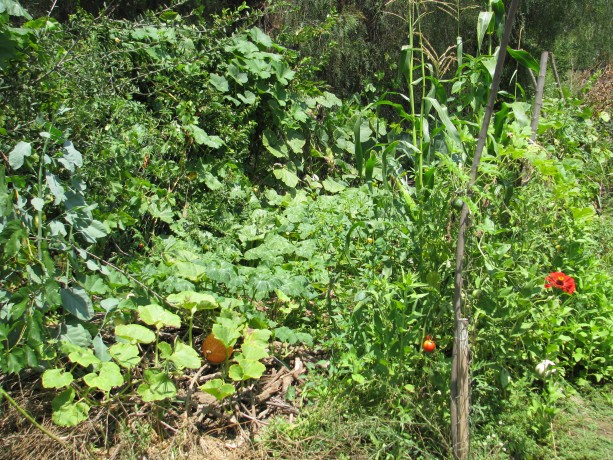
Squash, melons, tomatoes, flowers, tomatillos, sweet potatoes and more flourish along a chain link fence and on a wire-and-post trellis we set up over buried wood. Vertical space is perfect for vines; the vines provide shade and protection for other plants, and mulch plus a harvest when they die down. They are exciting and fun to watch grow as well. I’ve wanted to show you more of the garden, using video as well as photos. The summer garden is beautiful and full of life. Life in the ground, in the water, in the air and on every plant. Last year the pond had an overgrowth of pond weed and algae. Since our pond is natural – meaning that it has no liner, just compressed clay, and is cleaned only by plants and fish with no other aeration or filtration – the idea of adding algaecide is unthinkable. In great pond water there are as many if not more microbes as in good soil. Algaecide may advertise that it doesn’t harm fish or frogs, but it will kill the small pond life that is keeping your pond and its animals healthy. Seven small koi were added (rescued from a golf course pond where they had been dumped) in the hopes that they would eat the emergent pond weed as it grew out of dormancy. We hadn’t seen the koi and thought that they were dead. A couple of months ago they were sighted: all seven, each about a foot long and magnificent. We have no pond weed nor algae overgrowth thanks to these beauties.
In the following short video you’ll see some of the koi and possibly some of the bluegill and mosquito fish that also inhabit the pond. Notice a small blue dragonfly alighting on the bamboo pole. Birds call out all around. You’ll also hear my work shoes squeaking! The size and vigor of the water lilies is due to the healthy, microbially balanced water. We keep the pond topped up from the well. Well water here in San Diego County is notoriously salty and mineral-laden. Plants and microbes remediate that water, as is obvious in this video. The last part is of the native marsh fleabane which was sown by wild birds and flourishes around the pond. The small groups of flowers are perfect for our tiny native insects to land upon and feed. A honeybee uses it here. Enjoy with me a moment by the pond; the following link will send you to a Youtube video:
- Animals, Bees, Birding, Building and Landscaping, Chickens, Cob, Compost, Composting toilet, Fungus and Mushrooms, Gardening adventures, Giving, Health, Heirloom Plants, Hiking, Houses, Hugelkultur, Humor, Living structures, Natives, Natural cleaners, Other Insects, Permaculture and Edible Forest Gardening Adventures, Pets, Photos, Predators, Quail, Rain Catching, Recycling and Repurposing, Reptiles and Amphibians, Seeds, Soil, Vegetables, Water Saving, Worms
Special Tours for Aug. and Sept., 2014
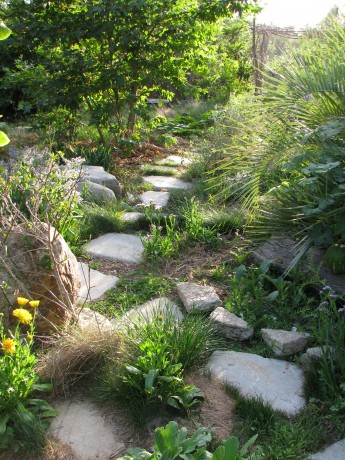
Come take a tour of a food forest! Normally tours of Finch Frolic Garden are held by appointment for groups of 5 – 15 people, Thursdays – Mondays. Cost is $10 per person and the tour lasts about two hours. By popular demand, for those who don’t have a group of five or more, we will be hosting Open Tour days for the first 15 people to sign up in August and September. They will be Sunday, August 10 and 24, Sept. 7 and 21, and Thursdays August 7 and 28, and Sept. 11 and 25. Tours begin promptly at 10 am. The tours last about two hours and are classes on basic permaculture while we tour the food forest. I ask $10 per person. Please reserve and receive directions through dianeckennedy@prodigy.net. Children under 10 are free; please, no pets. Photos but no video are allowed. Thank you for coming to visit! Diane and Miranda
- Animals, Bees, Birding, Books, Building and Landscaping, Chickens, Cob, Compost, Composting toilet, Fungus and Mushrooms, Gardening adventures, Heirloom Plants, Hugelkultur, Humor, Living structures, Natives, Natural cleaners, Other Insects, Permaculture and Edible Forest Gardening Adventures, Ponds, Predators, Quail, Rain Catching, Recycling and Repurposing, Reptiles and Amphibians, Seeds, Soil, Water Saving, Worms
Permaculture Lectures At Finch Frolic Garden, June 2014
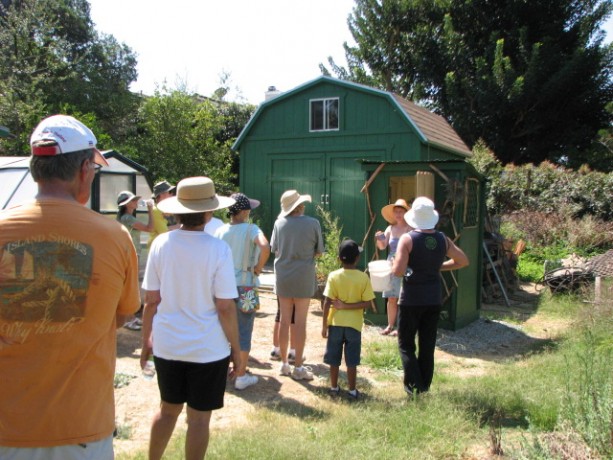
Tour Finch Frolic Garden! Permaculture Lectures in the Garden!
Learn how to work with nature and save money too
Finch Frolic Garden and Hatch Aquatics will present four fantastic, information-filled lectures in June. Join us at beautiful Finch Frolic Garden in Fallbrook, 4 pm to 6 pm, for refreshments and talks on…
Saturday, June 7: Introduction to Permaculture and Finch Frolic Tour: We’ll take you through the main precepts of permaculture and how it can be applied not only to your garden, but to yourself and your community. Then we’ll tour Finch Frolic Garden and show rain catchments, swales, plant guilds, polyculture, living buildings and so much more.
Saturday, June 14: Your Workers in the Soil and Earthworks: Learn the best methods for storing water in the soil and how to replace all your chemicals with actively aerated compost tea and compost.
Saturday, June 21: Aquaculture: You can have a natural pond – even in a tub! How natural ponds work, which plants clean water and which are good to eat. Even if you don’t want a pond, you’ll learn exciting information about bioremediation and riparian habitat.
Saturday, June 28: Wildlife in your Garden: What are all those bugs and critters and what they are doing in your yard? We’ll discuss how to live with wildlife and the best ways to attract beneficial species.
Your hosts and lecturers will be
Jacob Hatch Owner of Hatch Aquatics. With years of installing and maintaining natural ponds and waterways, and a Permaculture Design Course graduate, Jacob has installed earthworks with some of the biggest names in permaculture.
Miranda Kennedy OSU graduate of Wildlife Conservation and wildlife consultant, Miranda photographs and identifies flora and fauna and maps their roles in backyard ecosystems.
Diane Kennedy Owner of Finch Frolic Garden, lecturer, consultant, Permaculture Design Course graduate, former SDC Senior Park Ranger, Diane educates homeowners on how to save money and the environment while building their dream gardens.
Each class limit is 50 attendees, so please make pre-paid reservations soon before they fill up. Fee for set of four lectures and tour is $45 per person. Single session fee is $20 per person. Contact Diane Kennedy at dianeckennedy@prodigy.net for reservations and directions.
You will not want to miss this fascinating and useful information!
- Animals, Birding, Chickens, Gardening adventures, Heirloom Plants, Humor, Permaculture and Edible Forest Gardening Adventures, Photos, Ponds, Reptiles and Amphibians
Happy Easter!
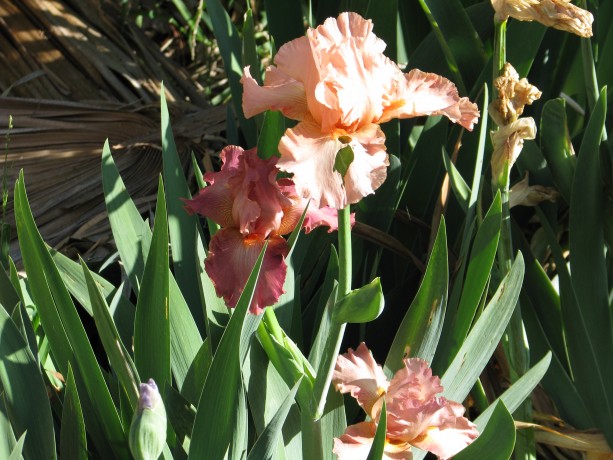
Heirloom irises from my good friend Jean are blooming. 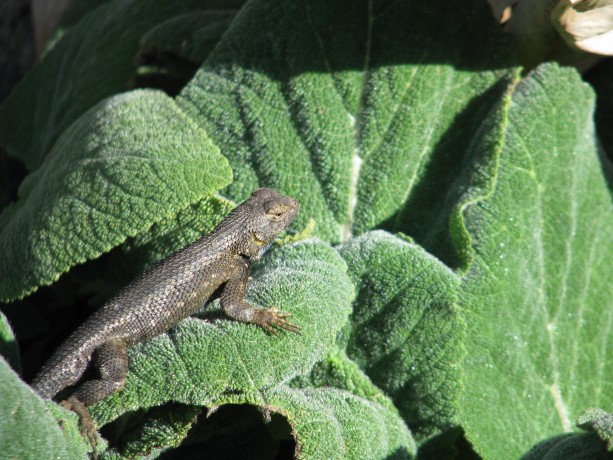
A Western fence lizard suns and guards his territory atop a clary sage leaf. See the flash of blue under his chin to attract the ladies? 
This green calla lily is gorgeous. 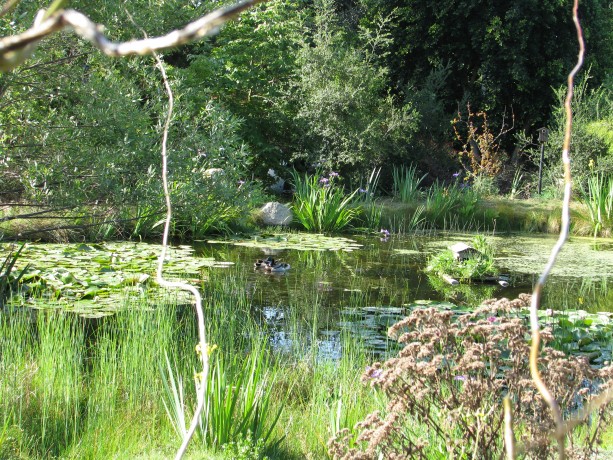
Framed by curly willow from the Withy Bird Hide, two drakes swim in the pond on Easter morning. 
Sweet peas are still blooming. They hold the permaculture precept of everything having three purposes: they are nitrogen fixers, they are edible, and they are gorgeous. 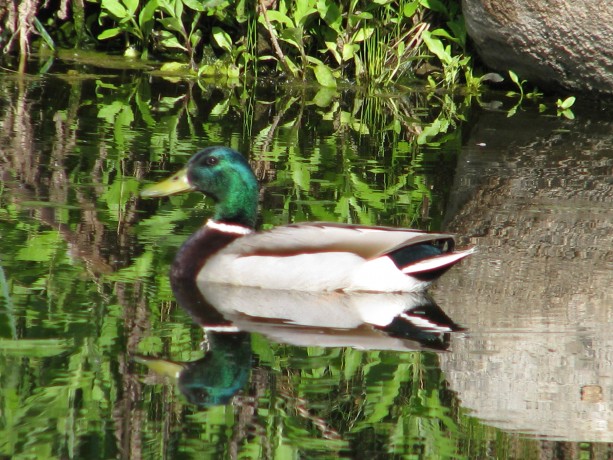
A fancy drake who showed up this morning. 
The irises surrounding the pond are spectacular right now. Blue, dark blue and yellow flag. 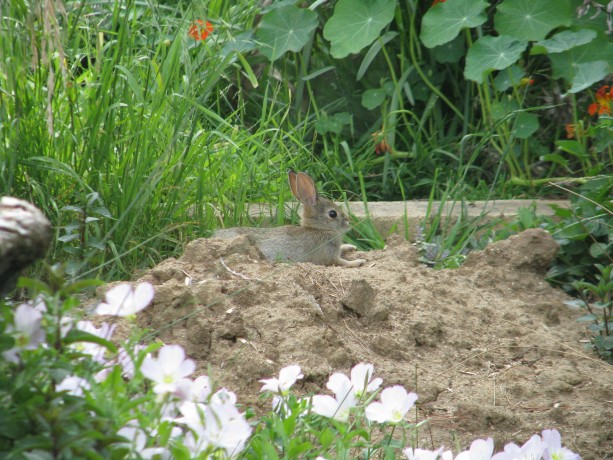
Baby bunny has been growing out his ears. He’s enjoying a warm dirt bath. 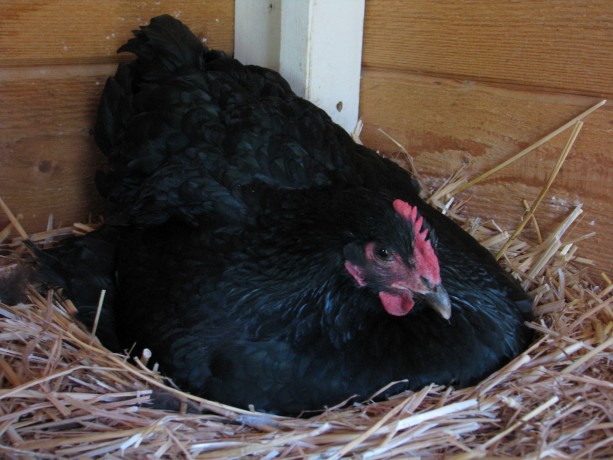
Mulan has gone broody. Such a large chicken puddles out over the wooden egg she’s trying to hatch. We’re feeding her an oatmeal mixture in a dish because she won’t come down during the day. 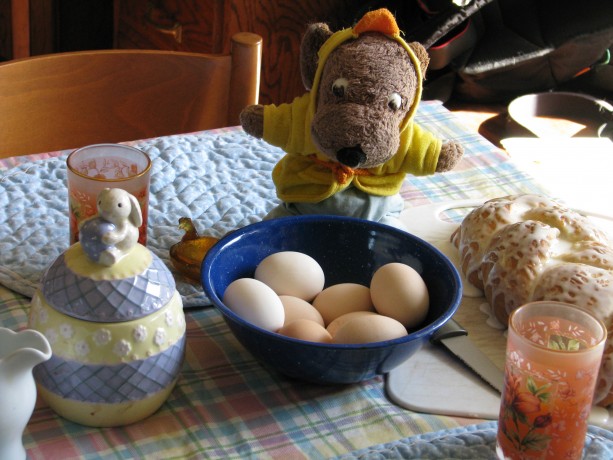
Easter breakfast. Hard boiled eggs, naturally colored by our hens, fresh tangerine juice, our traditional stollen from my mother’s recipe, and Peanut in his chicky robe ready to launch into the food. Peanut doesn’t act his age, of about 40+ years, but has traveled and been photographed extensively in Europe and Ecuador. Its nice that he wakes up for holidays. - Animals, Bees, Birding, Chickens, Cob, Compost, Composting toilet, Fungus and Mushrooms, Gardening adventures, Health, Heirloom Plants, Hiking, Humor, Living structures, Natives, Natural cleaners, Other Insects, Permaculture and Edible Forest Gardening Adventures, Pets, Photos, Ponds, Predators, Quail, Rain Catching, Reptiles and Amphibians, Seeds, Soil, Water Saving, Worms
Finch Frolic Facebook!
Thanks to my daughter Miranda, our permaculture food forest habitat Finch Frolic Garden has a Facebook page. Miranda steadily feeds information onto the site, mostly about the creatures she’s discovering that have recently been attracted to our property. Lizards, chickens, web spinners and much more. If you are a Facebook aficionado, consider giving us a visit and ‘liking’ our page. Thanks!
- Gardening adventures, Permaculture and Edible Forest Gardening Adventures, Ponds, Rain Catching, Soil, Water Saving
You Can Only Catch So Much Rain!
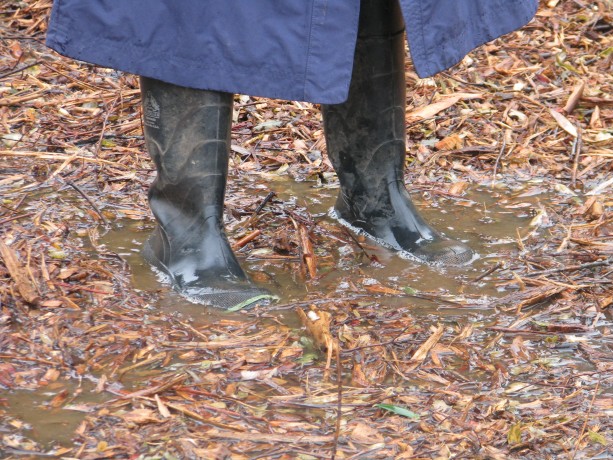 After a seriously dry and warm winter, last weekend we received most of our rain allotment over four days. Here in Fallbrook we received four inches. A long soaking rain would have been preferable, but I’m happy for what we received. Normally we receive downpours like cranky temper tantrums of the clouds that thunder down for a minute and then whimper away, but not this time.
After a seriously dry and warm winter, last weekend we received most of our rain allotment over four days. Here in Fallbrook we received four inches. A long soaking rain would have been preferable, but I’m happy for what we received. Normally we receive downpours like cranky temper tantrums of the clouds that thunder down for a minute and then whimper away, but not this time.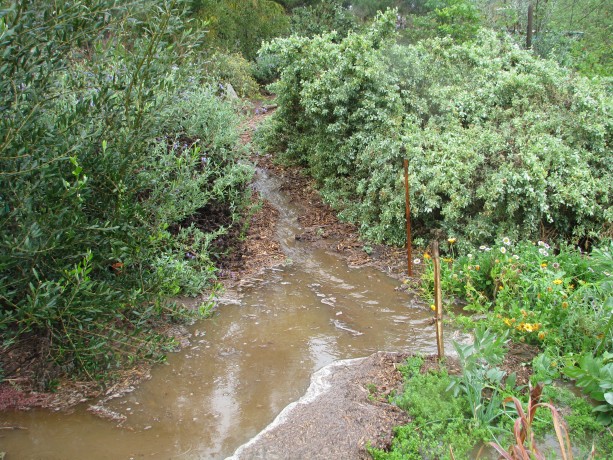
The pathway between the Mexican bush sage and quail bush became a river. Now we know where to put new swales. 
Water from the driveway was channeled down to the new veggie bed trenches, and filled them up. This storm had rain events where it would pour down buckets, and then become heavier and last for much longer than usual. The last storm of this type was back in December, 2010, which is when I lost chunks of property down into the streambed due to erosion across the property. Thanks to permaculture methods, the property received very little damage and no serious erosion.
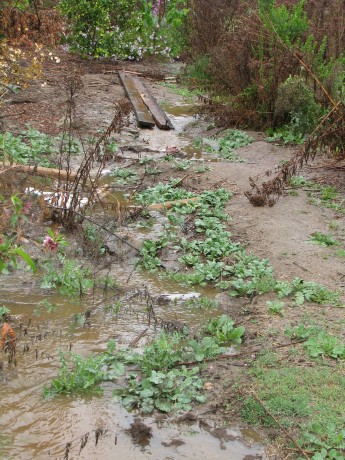
New temporary streams everywhere. This was a directed overflow from the ponds. If we had just received what had fallen on our property then we would have captured all of it. The downpours were so hard and long that we had tens of thousands of gallons of water flowing through from the street. My daughter and I left just after one of the last ginormous downpours and drove past a brown river running down the street and onto our property. It not only collected and flowed from other properties, but rain water was flowing from the cross street, Alvarado, down our street, through the neighbor’s property and through ours. It is amazing that we suffered as little damage as we did.
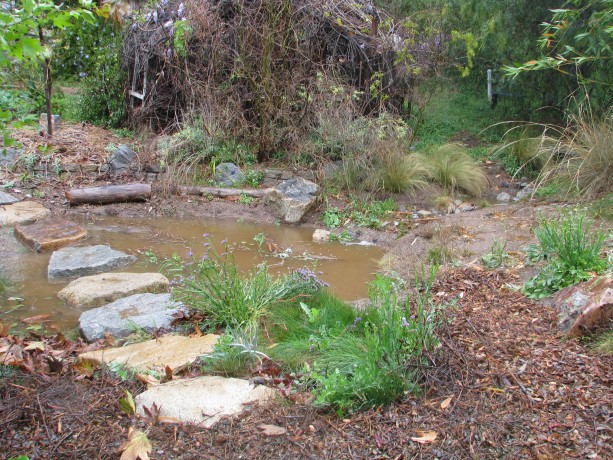
The large rain catchment basin worked beautifully, percolating well and slowing the flood. The rain catchment basins worked beautifully; the top one filled and percolated down many times, recharging the water table. Overflow systems worked well to channel water down an overflow pipe and into the streambed below. Water from the driveway was diverted to the long, level trenches we’d dug under our new ‘sunken’ veggie beds, and it worked well. It was good to see the overflows working, because there was no way in the world to capture the amount of water that flowed through this property. Oh, if only I could have! Let’s see: one inch of water falling in one hour on one acre is almost 27,000 gallons of water. I have 1.68 acres and we received four inches. That means that about 181, 440 gallons of water fell directly on my property alone. I couldn’t begin to calculate how much water flowed onto the property from the street and neighbor’s properties during the heavy rainfall times. Sigh. I’ll have to keep working on catching more! I’m water greedy!
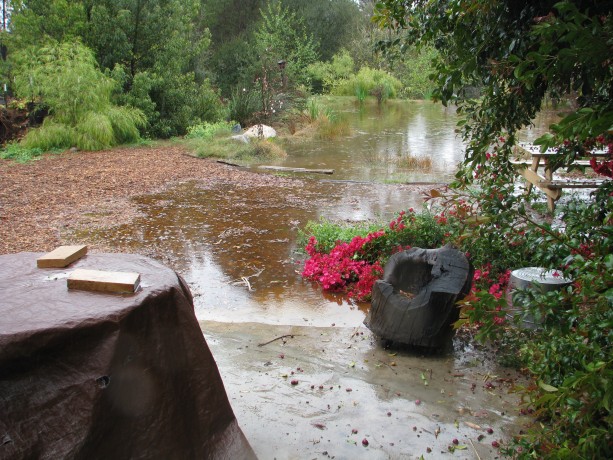
The big pond backed up to the cement slab where the cob oven sits! It wasn’t until the last day that water backed up and overflowed the cement channel, effectively removing mulch we’d just laid over plywood and cardboard on the pathways. One area, notorious for its squidgy clay when wet, emulated quicksand under the layer of mulch (the boot photo at the top).
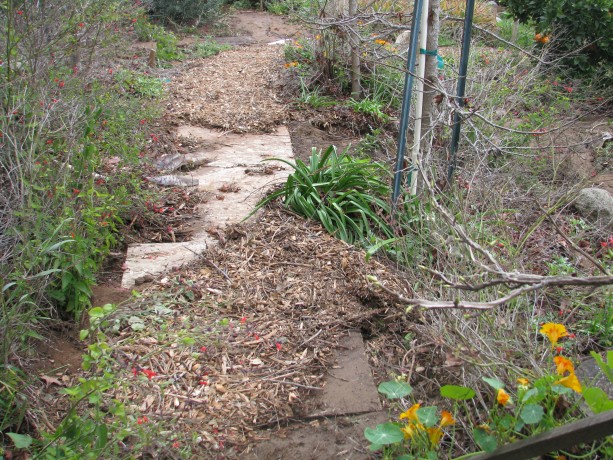
Plywood that had days before been topped with mulch. Repair work was time-consuming but not difficult, only we need more mulch! One of the great benefits of the overflow, however, is that it deposited sand and decomposed granite over the heavy clay in the beds. The storm helped amend the soil in these troublesome areas!

You can see the difference between the sandy silt that once belonged to our neighbors, deposited on the shiny thick clay of our garden bed. Thanks! In fact, outside of our gate where the street water flows to enter the property a lot of silt accumulated. We were out there with wheelbarrows today clearing it out and using it. It is a great mixture of sand, decomposed granite and organic materials! Beautiful stuff. We hauled it down the hill and used it to plant potatoes in milk crates, mixed with a little pigeon poo from our generous neighbors. I had been wondering where I’d be able to get the soil for those crates. We still have a lot left (more to collect, too, but it is heavy business) for other projects.
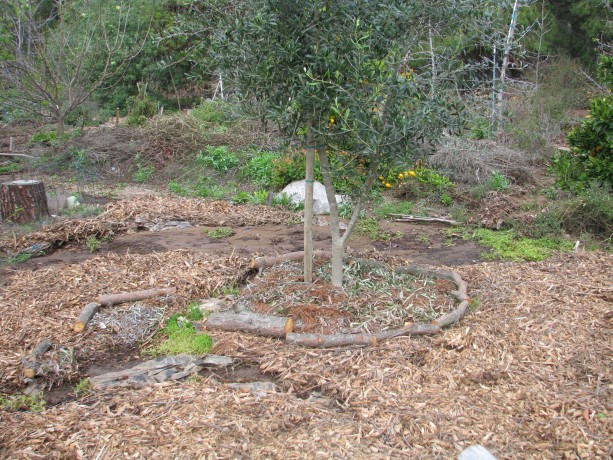
Just before the rains we’d covered this area in newspaper topped by mulch. You can see the river of water behind the tree and the shifted mulch in front. Strawberry plants under the olive were covered with debris. So on top of trying to catch up with the early spring here (did we even have winter??), we’ve been repairing the trails and making the walkways safe for the tours which have begun. It is a good lesson about where to place more swales and rain catchment basins for the next strange rain event. Since its March already, I don’t really have to worry about possible flooding for another twelve months or more!
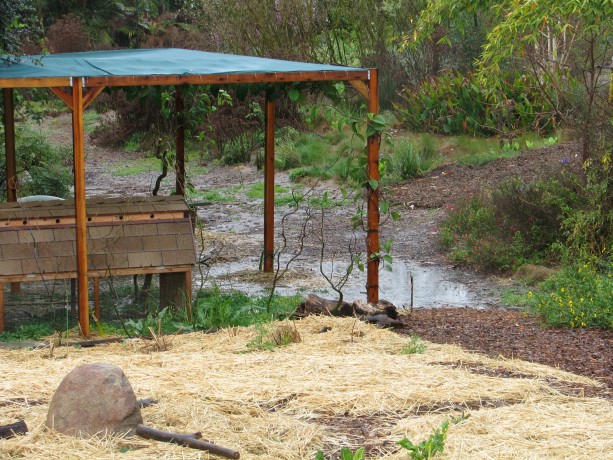
By the end of the four days everything overflowed, but not violently. Here we have a temporary pond by the Mock Pavilion. - Animals, Gardening adventures, Hugelkultur, Natives, Other Insects, Permaculture and Edible Forest Gardening Adventures, Ponds
Then and Now
This photo was taken just as work was begun on transforming the property into a garden, in February, 2011.
This photo was taken last Thursday, Oct. 31, 2013, from the same location.
This view may look weedy, especially in the early morning light on this brilliant Halloween morning. What you are seeing is the first bog, which is the green spot in the foreground. The dirt area is the overflow, if torrential rains ever come again. To the left, the tall bushes constitute the withy hide, and to the left is the big pond, although you have to take my word for it. Tall bamboo arches over the stumps of the palm trees in the above photo, which are trellises for roses and other vines. A nectarine branch is in the right foreground. The tall flowering plants are a native called fleabane. They reseed readily, and I allow them to because of several reasons. They grow five to six feet tall and help shade smaller trees and plants against the harsh summer sun, protecting them from sun scald. They also die off in the winter, making good hugelkultur material. The purple flowers, which are in the above photo now turning into fuzzy seed clumps, are attractive. The most important thing though is that they are excellent hosts for native insects of all kinds. Ladybugs, lacewings, spiders, and hundreds of tiny wasps and flies, many of which are parasitic, all love these flowers. All summer long they are alive with life. Inviting in the native pollinators, and growing a polyculture garden, is the first line of defense in growing naturally.
Allowing nature to define parts of your garden leads to happy surprises and lots of help from unexpected friends, such as bugs, birds and lizards. This kind of garden is endlessly interesting, with new things to study every day.
The following photos were all taken the same brilliant morning, Oct. 31, 2013. Here in San Diego county we were having what is called a Santa Ana, where warm, dry winds from the desert blow westward, as opposed to the more humid eastward flow of air from the ocean that we normally have. Santa Anas can bring heavy winds and make tinder-dry weedy hills a fire hazard, but this year we’ve been lucky and no major fires have happened. We even had almost 3/4 ” of rain, last week, which is practically unheard of for October. The warm Autumn sunshine was intense and lovely, and I had to take photos even though the light was too strong for good ones.
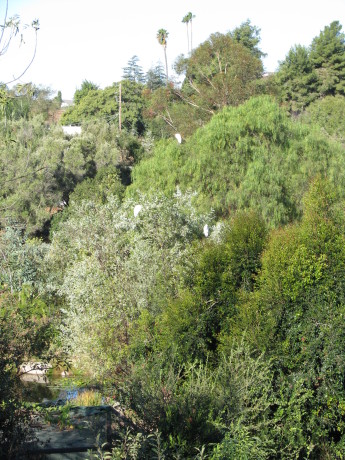
We went up on the roof to view these three greater egrets perched in our trees over the pond. 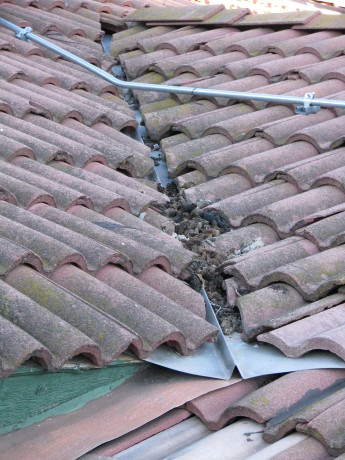
Being on the roof is an education. Here is lots of racoon poo between the tiles. Why?! 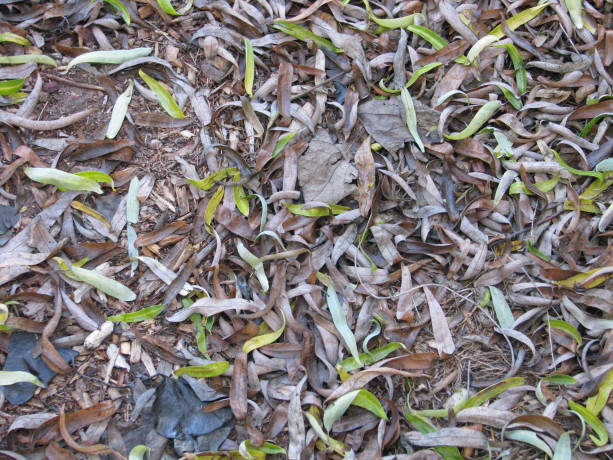
We don’t have dramatic Fall colors here, but the subtle Autumn hues of leaves is lovely. 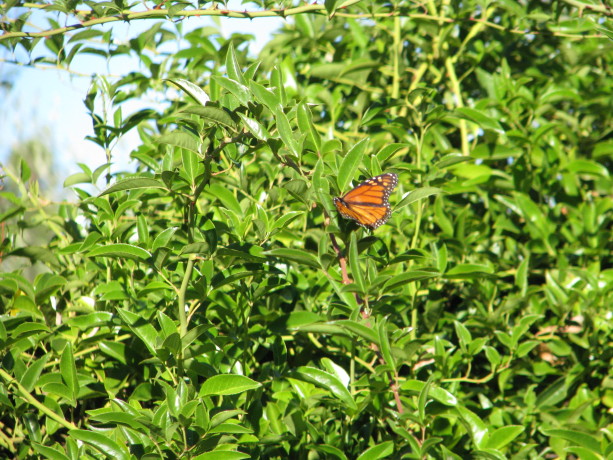
We still have Monarch butterflies. 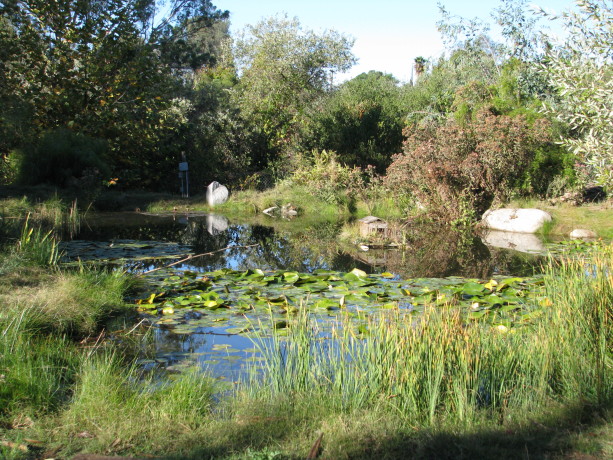
The big pond in early morning light. 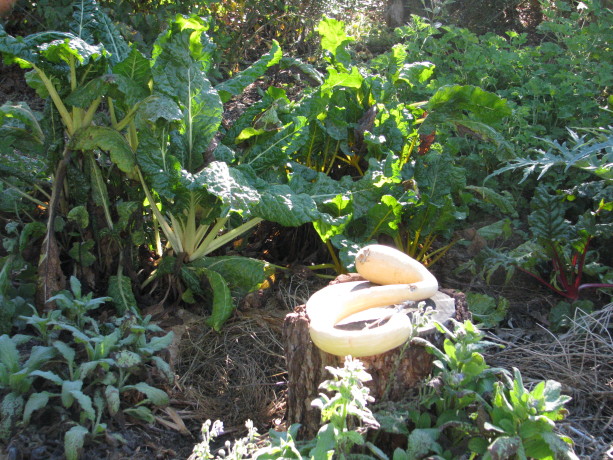
A zuchianno rampicante reclining on a stump. (Its a squash!). 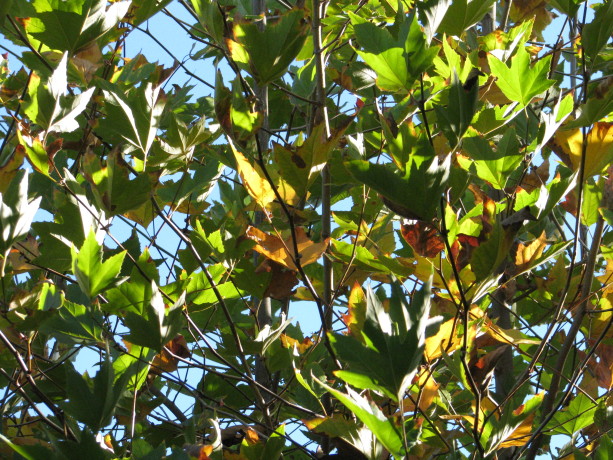
Morning sun through a Fall-leaved sycamore. Beautiful. 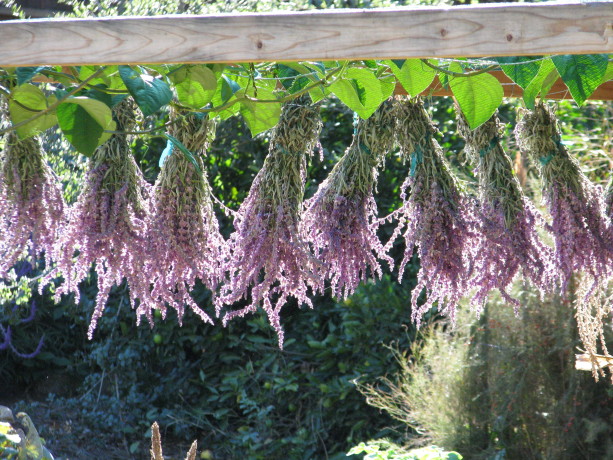
Mexican bush sage hanging up to dry. 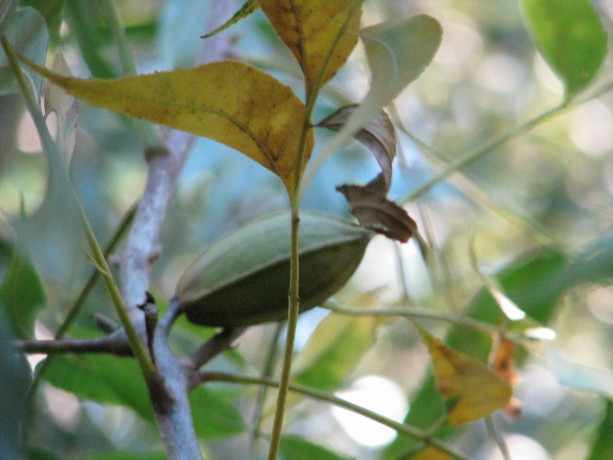
Our little pecan tree put on about six this year! Next year, tons! 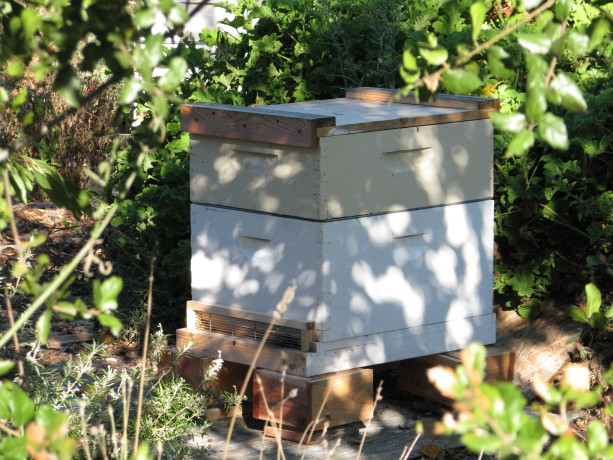
Beehive warming up. 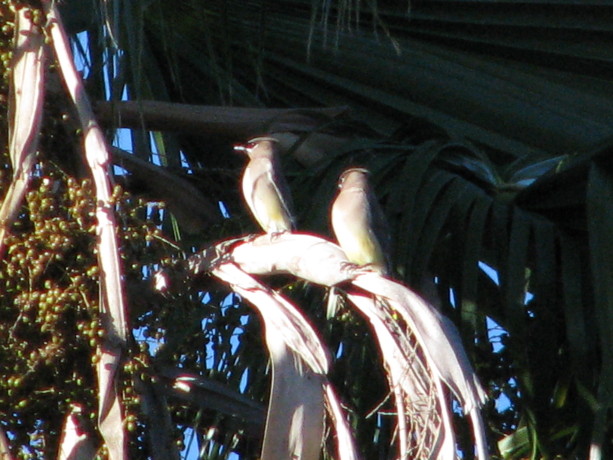
Ceder waxwings (my favorite bird) in the big palm. 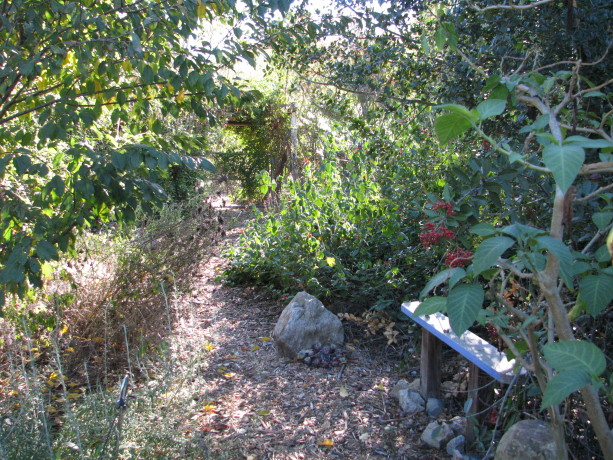
The Bee Garden. 
The liquidambers, also known as sweet gums, are just beginning to turn color. Lots of deciduous trees means lots of leaf mulch, and more warmth reaching the ground during the winter. 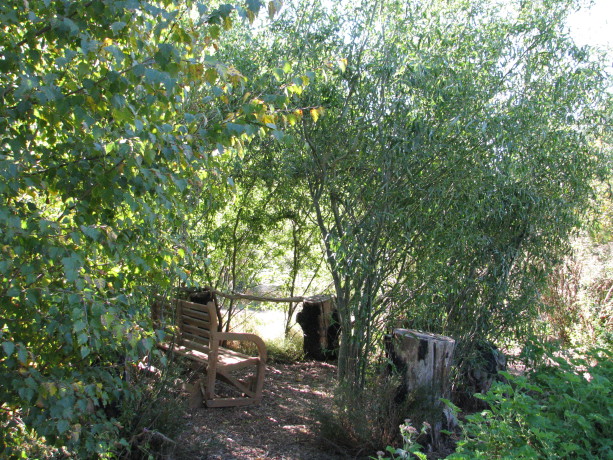
The entrance to the withy hide, with the pond in the distance. 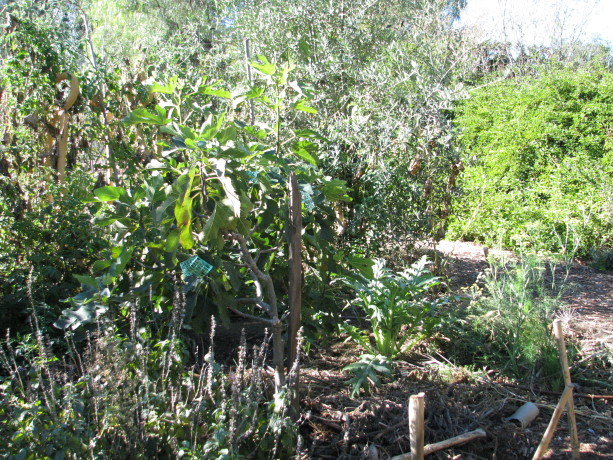
The Mission fig,with artichoke, anise and sage.. 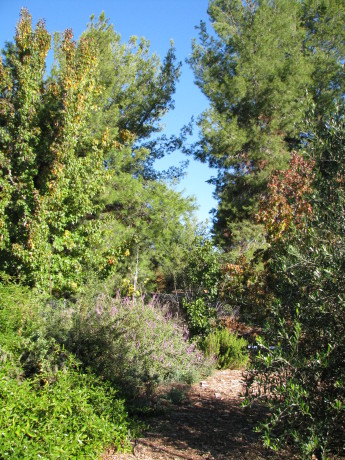
The canopy is growing. 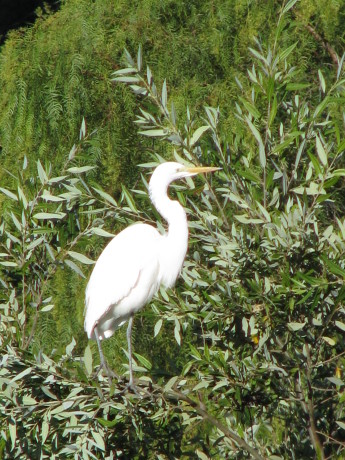
Greater egret enjoying the sun. - Animals, Chickens, Cob, Compost, Composting toilet, Fruit, Gardening adventures, Giving, Grains, Health, Herbs, Houses, Hugelkultur, Humor, Living structures, Natives, Natural cleaners, Permaculture and Edible Forest Gardening Adventures, Ponds, Rain Catching, Recipes, Seeds, Soil, Vegan, Vegetables, Vegetarian, Worms
San Diego Permaculture Convergence, Nov. 9 – 10, 2013
There is a fantastic, information-packed permaculture convergence coming up at the beautiful Sky Mountain Institute in Escondido.
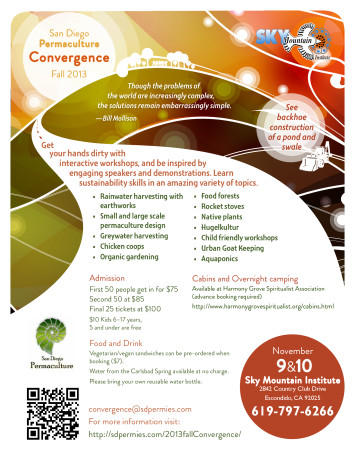 It will be two days packed with great information for a very reasonable price; in fact, scholarships are available. Check out the website at convergence@sdpermies.com. On that Sunday I’ll be teaching a workshop about why its so important to plant native plants, how to plant them in guilds using fishscale swales and mini-hugelkulturs. Come to the convergence and be inspired!
It will be two days packed with great information for a very reasonable price; in fact, scholarships are available. Check out the website at convergence@sdpermies.com. On that Sunday I’ll be teaching a workshop about why its so important to plant native plants, how to plant them in guilds using fishscale swales and mini-hugelkulturs. Come to the convergence and be inspired! -
New Bog
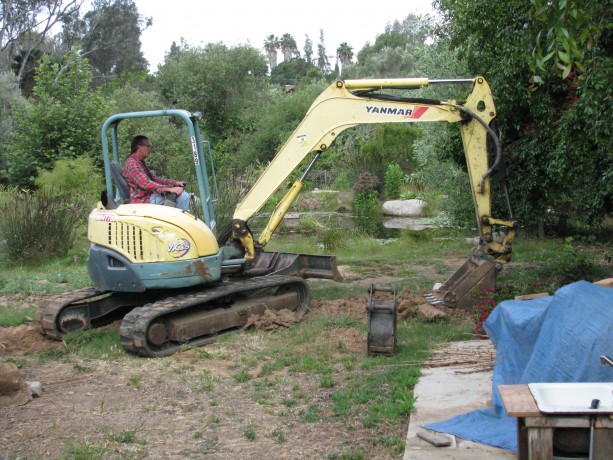
Steve demostrating years of expertise by finessing this large piece of equipment. Last week a new bog area was added to the main pond. The first bog area was dug by hand, created so that there would be a shallow, flat habitat for wading birds and tadpoles.
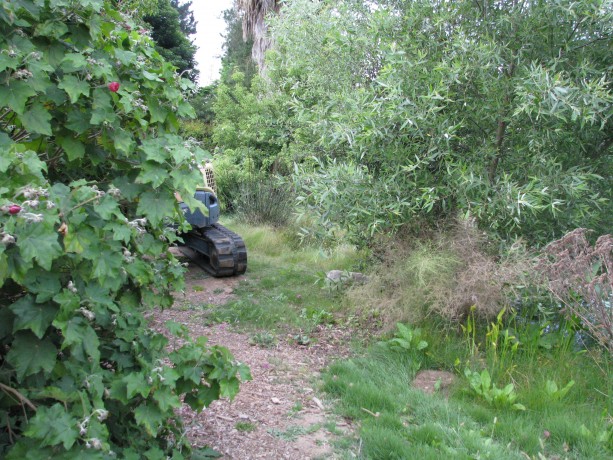
Preparing to start. This is called adding edge, which is an important component of any permaculture design. The first bog is connected to the series of rain catchment basins and now is the link between rain overflow system and the large pond. This year no rainwater left the property; it was all captured. Edge areas in both water and plant design provide more sun and growth areas than a round or straight design. More interesting things happen on the edge.
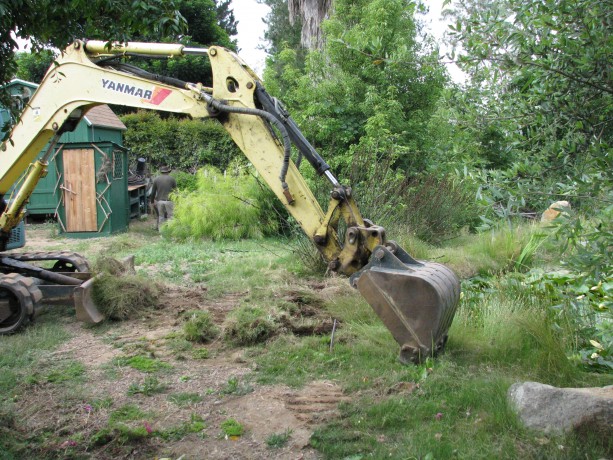
Gentle scraping with the bucket to discover where the subterranean irrigation lines were without stretching them. This bog area was dug up by a tractor bought from a farm auction that I’d shared rental with a friend. It took a large mound of dirt and filled in some dips, leveling a walking and working area.
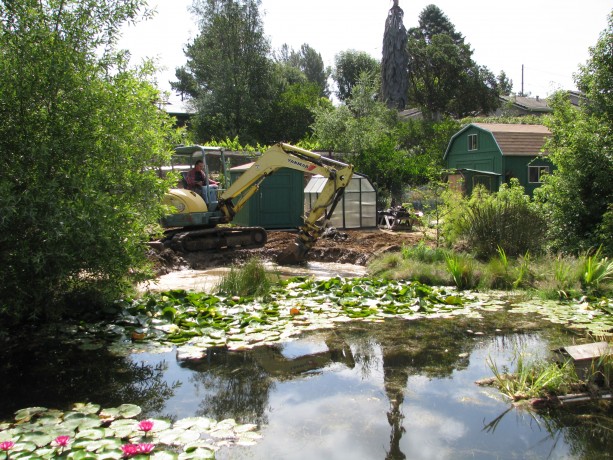
Another, cross-pond view of the new bog. Steve, who among his many talents is also a heavy equipment operator, did a terrific job grading and then expanding the pond. A small problem is that he found some more porous soil with the clay, so the water level on the pond dropped.
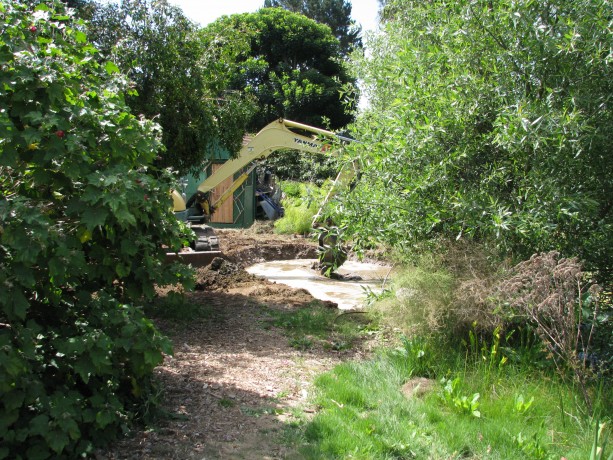
Water is filling in. We’re seeing how far it goes down to tell if the seepage is occurring on the edge or on the bottom of the new area. Once found, we’ll move extra clay over and tamp it all in.
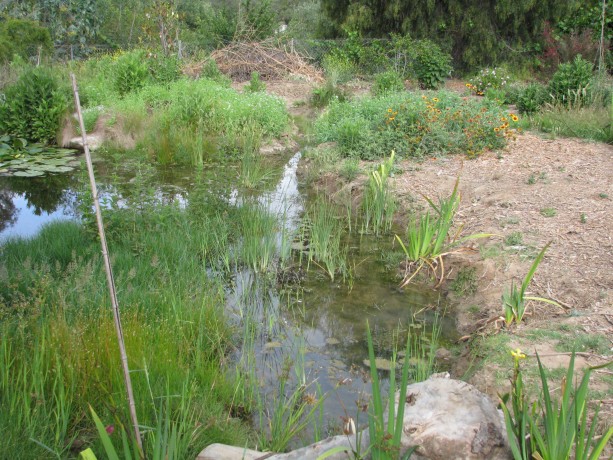
The first, hand-dug bog now filling with plants. Plants Jacob has put into the first bog include graceful cattails, which are a dwarf cattail that isn’t so invasive, iris, rushes, watercress, and some Mexican waterlily.

Sophie admiring the first bog. Very soon the plants will cover the bog areas providing excellent cover for many animal species which… wait for it… live on the edge.
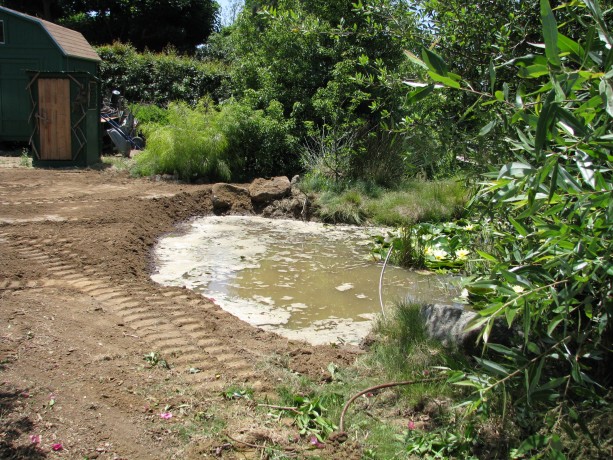
Waiting to see how it sealed and then ready for planting. - Compost, Composting toilet, Gardening adventures, Hugelkultur, Permaculture and Edible Forest Gardening Adventures, Ponds, Rain Catching, Soil
Rain Catchment Awesomeness (and some BSP)

Water flowed over the stone steps First, a little BSP (blatant self-promotion). There is a wonderful ezine called San Diego Loves Green featuring topical local articles and snippets that reflect on the growing green community here in, you guessed it, San Diego. The San Diego Permaculture Group has an ongoing column, and yesterday I was the guest writer. My article is on the importance of planting natives , with some information that you might find surprising, or that you may have already read in my blog about the same subject. Also (more BSP) if any of you attended the Southern California Permaculture Convergence this weekend, and still yet, if any of you listened to my talk on soil, first of all I’d like to thank you for your attention and attendance, and I hope I answered your questions and solved some problems for you. You can search on my blog for many posts concerning nitrogen -fixing, or 50 Ways to Leave Your Compost , and see my composting toilet (I went to a Garden Potty).
We had almost two inches of rain on Thursday night. In San Diego we rarely receive the long soaking rains that we really need. Instead we must be ready for flash floods. If you are familiar with Finch Frolic and the labors we’ve been undertaking in the last two years to hold the rainwater, then you may be curious to find out how the property survived this last middle-of-the-night flooding and hailstorms. If you remember, not only is there the water flowing off the roof and falling onto the watershed property, but also an unmeasurable amount that is purposely channelled runoff from all the neighbor’s properties that runs through mine.
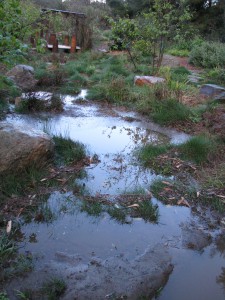
All basins full! Since the permaculture project was installed I haven’t had any of the erosion that plagued the site. As of last year I’m pretty sure that every drop that falls on my property is caught, in rain catchment basins, the ponds, and in the loam and compost in the guilds. The challenge was to also keep all the neighbor’s water on my property as well! I’m thrilled to say that we almost did it!
There is a new bog area being designed by Jacob Hatch just above the big pond.
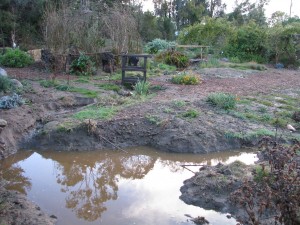
The new bog area This area had been designed to channel overflow water from the rain catchment streams around the pond and down a black tube to the stream bed below. Greedy me wants all that water! With the creation of another silt basin, and now that there is vegetation in the stream to hold onto the silt, I’ve made the water now flow directly into the big pond. There are planned overflows from the big pond, and water did overflow where it was supposed to.
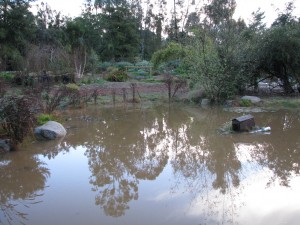
The big pond was filled to capacity, making the duck house do a sinking ship impression because of the length of the rope attached to the anchor wasn’t long enough. The first rain catchement basin was enlarged a lot so as to catch water higher on the property.
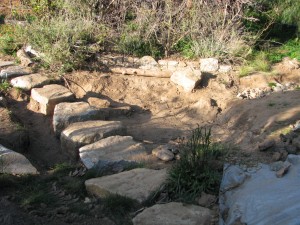
The first catchment basin was deepened There is decomposed gravel in that one so the water perculates quickly, thank goodness, as most of the other basins hold water due to the clay composition of the soil.
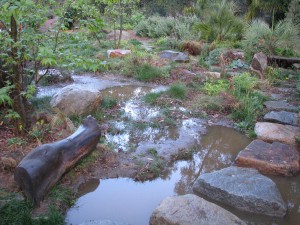
Water following the basins. Also, a rain catchement basin was created along the top of the cement channel that normally funnels water off the property.
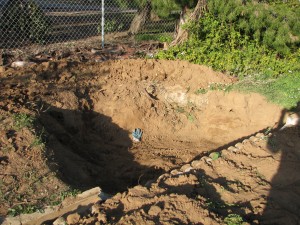
New basin, empty A series of these will be created all along the channel, allowing water to slow, gather and perculate along the length of the property, with no outlet at the end.
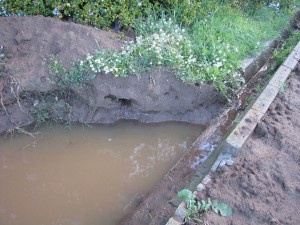
Full! This will take some of the flow pressure off of the water diverted down into the main series of basins.
The only area breached was actually due to a gopher hole whose origin must be in the stream. I could tell by the swirls in the mulch where the erosion happened.
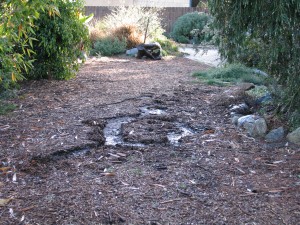
Swirls tell of a breach. There is also the slight problem of water flowing down my own driveway and then down the trail.
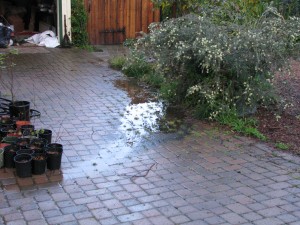
Water funneled down my driveway. I think a small hugelkultur bed might slove that problem.
The verdict? Almost all the water was retained on the property,even that of the neighbor’s! A few tweaks and we are well on our way to total rainwater dominance! Mwwahahahahahahaha!

Mwwahahahahahahaha!

